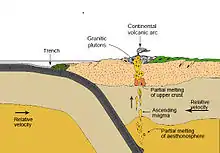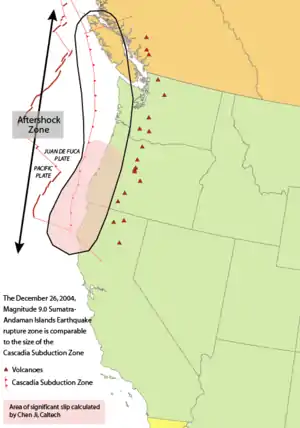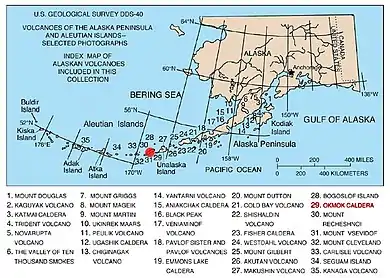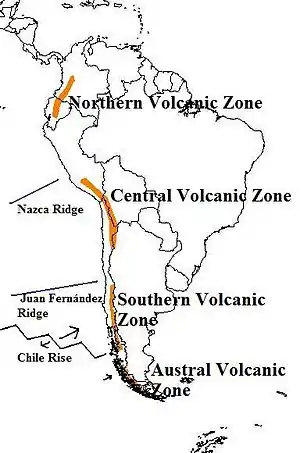A continental arc is a type of volcanic arc occurring as an "arc-shape" topographic high region along a continental margin. The continental arc is formed at an active continental margin where two tectonic plates meet, and where one plate has continental crust and the other oceanic crust along the line of plate convergence, and a subduction zone develops. The magmatism and petrogenesis of continental crust are complicated: in essence, continental arcs reflect a mixture of oceanic crust materials, mantle wedge and continental crust materials.
Origin

When two tectonic plates collide, relatively denser oceanic crust will be subducted under relatively lighter continental crust. Because of the subduction process, the relatively cooler oceanic crust, along with water, is subducted to the asthenosphere, where pressures and temperatures are much higher than the surface of Earth. Under such conditions, the downgoing plate releases volatiles such as H2O and CO2, which cause partial melting of the above asthenosphere.[1] This process can create relatively buoyant magma, which subsequently forms a series of volcanoes at the surface along the subduction zone. There are some researchers who argue that refertilization of arc lithospheric mantle may also be an important process associated with arc magmatism.[2][3] Because the subduction zone (which is also the plate boundary) is generally an arc-shape, geologists named those volcanoes volcanic arcs. A volcanic arc built on continental crust is called a continental arc; when built on oceanic crust the volcanoes form an island arc.
Petrogenesis and magmatism
Petrogenesis
The origin of igneous rock, or petrogenesis, in continental arcs is more complicated than that in oceanic arcs. The partial melting of the subducting oceanic slab generates primary magma, which would be contaminated by the continental crust materials when it travels through the crust. Because the continental crust is felsic or silica while the juvenile primary magma is typically mafic, the composition of magmas in continental arcs is the product of mixing between igneous differentiation of mafic magmas and felsic or silica crust meltings.[2] The mixing of existing continental crust, lower part of lithosphere or lithospheric mantle under the continental crust, the subducting oceanic crust and sediments, the mantle wedge and the underplates materials together is the main source of continental arc rocks.[4]
Magmatism

The dehydration of the downgoing slab and the partial melting of asthenosphere together generate the primary magma of continental arcs. Primary magma is composed of olivine tholeiitic basalt because of mixture of peridotites from the mantle wedge and large ion lithophile enriched (LIL-enriched) fluids from the dehydrating subducting plate.[4] Because the larger thickness and lower density, the continental crust is likely to prevent the upwards rising of primary magma. Ascending primary magma is likely to pond at the bottom of continental crust, forming a magma chamber. In this chamber an underplating process will take place, the assimilation and fractional crystallization of primary magma and lower crustal rocks forms underplate at the bottom of crust.[4][5]
Through those procedure the olivine tholeiitic primary magma would change to calc-alkaline magmas and more evolved and enriched alkaline or siliceous magmas.[6] A further enriched source may be provided by the tectonic erosion process that causes scraping and dragging of lower continental lithosphere into the melting zone. Thus, a high concentrations of Rb, Cs, Ba, K, Th, and LREE (light rare-earth elements) and enriched isotopes can be found in the continental arc magmas.[7]
Intensity of arc magmatism
The geothermal structure in a subduction zone determines the melting rate of subduction slab and asthenosphere. The change in isotherm structure may have significant impact on the intensity of magmatism. Some factors may contribute to the change in geothermal structure: a) the change in convergence velocity of two plates in subduction zone;[4] b) the dipping angle of subduction slab;[4] c) the amounts of subducted low temperature materials (water and oceanic sediments);[1] d) the mantle/asthenosphere upwelling event (slab window[8]/slab breakoff[9]).
Petrology
The petrogenesis of continental arcs is generally different from that of oceanic arcs, so more calc-alkaline and alkaline rocks can be found at a continental arc, with fewer tholeiites and low-K rocks.[4]
Calc-alkaline phenocryst-rich dacite, andesite and rhyolite rocks are abundant in continental arc. These rocks contain hydrous minerals biotite and hornblende partially resorbed in magmatic process. Strongly-zoned plagioclase with sieve texture also occurs in those rocks. Granodiorite, tonalite and diorite are most common intrusive rocks found in continental arcs.[10]
Erosion process
The erosion of continental arcs is a part of the main process of global lithosphere circulation. According to relative study,[11] the contribution of continental arc erosion in total continental crust loss is nearly 25%. A process called tectonic erosion happens when friction force during convergence scrapes off huge amount of rocks from the base of continental arcs. Also, precipitation on the continental-arc orogen itself is another erosion process. The debris from the continental arc would deposit in the subduction zone as turbidite. The undergoing subduction forces sediments to accretively add to the accretionary wedge or to subduct into the asthenosphere. Then part of sediments would be recycled through volcanic activities, and thus return to the continental crust, while another part would form new mantle material.
Distinctions between different arcs
The concepts "island arc", "volcanic arc", "oceanic arc" and "continental arc" may be confused:
- Volcanic arcs are made of an arc-shaped chain of volcanoes, the position of which could be continental or mid-ocean.
- Island arcs must be offshore, but they do not necessarily have to be volcanic (e.g. the non-volcanic Hellenic arc).
- Oceanic arcs are volcanic arcs built on oceanic crust, as opposed to continental arcs, which are built on continental crust.
- The composition of oceanic arc crust is different from that of continental arc crust. The oceanic arc crust is more mafic (basaltic/gabbroic) while the continental arc crust is prone to intermediate or felsic composition (andesitic/dioritic).[12]
In some cases, both a continental arc and oceanic arc can form along the strike of a single subduction zone (e.g. Aleutian Islands and Alaska Peninsula).
Table of continental arcs
| Continental arc | Country | Trench | Overriding Plate | Subducting plate |
|---|---|---|---|---|
| Cascade Volcanic Arc | United States and Canada | Cascadia Subduction Zone; no physical oceanic trench can be identified[13][14] | North American Plate | Juan de Fuca Plate, Explorer Plate, and Gorda Plate |
| Aleutian Arc | United States | Aleutian Trench | North American Plate | Pacific Plate |
| Kamchatka | Russia | Kuril–Kamchatka Trench | Eurasian Plate | Pacific Plate |
| Andean Volcanic Belt | Colombia, Bolivia, Peru, Ecuador, Chile and Argentina | Peru–Chile Trench | South American Plate | Nazca Plate and Antarctic Plate |
| Central America Volcanic Arc | Guatemala, El Salvador, Honduras, Nicaragua, Costa Rica, Panama | Middle America Trench | Caribbean Plate | Cocos Plate |
| Gangdese batholith | Tibet, China | No longer existent | Lhasa terrane | Neotethyan ocean |
 Cascade Volcanic Arc.
Cascade Volcanic Arc. The Aleutian Arc, with both oceanic and continental parts.
The Aleutian Arc, with both oceanic and continental parts. Kamchatka Arc, Eastern Russia.
Kamchatka Arc, Eastern Russia. Andean Volcanic Belt
Andean Volcanic Belt
See also
References
- 1 2 Van Der Pluijm, B. A.; Marshak, S. (2004). Earth Structure (2 ed.). New York: Norton. p. 442. ISBN 978-0-393-92467-1.
- 1 2 Chin, Emily J.; Lee, Cin-Ty A.; Tollstrup, Darren L.; Liewen, Xie; Wimpenny, Josh B.; Yin, Qing-Zhu (2013). "On the origin of hot metasediment quartzites in the lower crust of continental arcs". Earth and Planetary Science Letters. 361: 120–133. Bibcode:2013E&PSL.361..120C. doi:10.1016/j.epsl.2012.11.031.
- ↑ Chin, Emily J.; Lee, Cin-Ty A.; Barnes, Jaime D. (2014). "Thickening, refertilization, and the deep lithosphere filter in continental arcs: Constraints from major and trace elements and oxygen isotopes". Earth and Planetary Science Letters. 397: 184–200. Bibcode:2014E&PSL.397..184C. doi:10.1016/j.epsl.2014.04.022.
- 1 2 3 4 5 6 Winter, John D. (2001). An Introduction to Igneous and Metamorphic Petrology. Upper Saddle River, New Jersey: Prentice-Hall Inc. ISBN 978-0321592576.
- ↑ Pitcher, W. S.; Atherton, M. P.; Cobbing, E. J.; Beckinsale, R. D. (1985). Magmatism at a Plate Edge: The Peruvian Andes (1 ed.). Springer. ISBN 978-1489958228.
- ↑ Harmon, R. S.; Barreiro, B. A. (1984). Andean Magmatism: Chemical and Isotopic Constraints (Shiva Geology) (1 ed.). Boston: Birkhäuser. ISBN 978-0906812617.
- ↑ Pearce, Julian A.; Parkinson, Ian J. (1993). "Trace element models for mantle melting: application to volcanic arc petrogenesis". Geological Society of London, Special Publications. 76 (1): 373–403. Bibcode:1993GSLSP..76..373P. doi:10.1144/GSL.SP.1993.076.01.19. S2CID 128765455.
- ↑ Zhang, Zeming; Zhao, Guochun; Santosh, M.; Wang, Jinli; Dong, Xin; Shen, Kun (2010). "Late Cretaceous charnockite with adakitic affinities from the Gangdese batholith, southeastern Tibet: Evidence for Neo-Tethyan mid-ocean ridge subduction?". Gondwana Research. 17 (4): 615–631. doi:10.1016/j.gr.2009.10.007.
- ↑ Ji, Weiqiang; Wu, Fuyuan; Li, Jinxiang; Liu, Chuanzhou; Liu, Chuan-Zhou (2009). "Zircon U–Pb geochronology and Hf isotopic constraints on petrogenesis of the Gangdese batholith, southern Tibet". Chemical Geology. 262 (3–4): 229–245. doi:10.1016/j.chemgeo.2009.01.020.
- ↑ Roden-Tice, Mary. "Earth Materials II – Petrology Course" (PDF). State University of New York at Plattsburgh. Archived from the original (PDF) on 23 November 2015. Retrieved 9 January 2015.
- ↑ Clift, Peter; Vannucchi, Paola (2004). "Controls on tectonic accretion versus erosion in subduction zones: Implications for the origin and recycling of the continental crust" (PDF). Reviews of Geophysics. 42 (2): RG2001. Bibcode:2004RvGeo..42.2001C. doi:10.1029/2003RG000127.
- ↑ Filedner; Moritz, M.; Klemperer, Simon L. (2000). "Crustal structure transition from oceanic arc to continental arc, eastern Aleutian Islands and Alaska Peninsula". Earth and Planetary Science Letters. 179 (3): 567–579. Bibcode:2000E&PSL.179..567F. doi:10.1016/S0012-821X(00)00142-4.
- ↑ Lillie, Robert J. (4 June 2001). "Subduction in the Pacific Northwest: Geology training manual for Olympic National Park" (PDF). Geoscientists-In-the-Parks document, 1999-OLYM. Denver, Colorado: National Park Service. p. 17. Archived from the original (PDF) on 29 December 2014. Retrieved 29 December 2014.
- ↑ "Pacific Mountain System – Cascade volcanoes", Earth Science Concepts, United States National Park Service, archived from the original on 2007-05-31